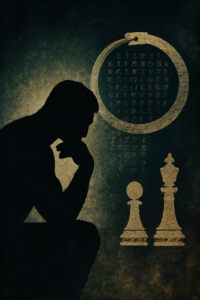The Silent Teachers: How Chess and Carrom Prepare You for Mastering Financial Markets

In the fast-paced and often unpredictable world of financial markets, success is not purely dependent on mathematical models or advanced algorithms. Instead, it’s a game of strategy, precision, adaptability, and patience—qualities that are not only cultivated in trading but also in seemingly unrelated activities like chess and carrom. These classic games harbor profound lessons for traders navigating the turbulent waters of stocks, forex, commodities, or cryptocurrencies.
Let’s explore how these games serve as silent teachers, with real-world trading examples to reinforce the concepts.
1. The Essence of Strategy and Planning
Financial markets are like a grand chessboard or a carrom board, where every move you make has consequences. Whether managing risk, executing trades, or planning portfolio allocation, having a well-thought-out strategy is essential.
Chess: Strategic Depth in Market Analysis
Chess trains your brain to think ahead, calculate risk, and anticipate outcomes—just like a trader analyzing charts and market trends.
Real-World Example: Warren Buffett, often referred to as the “grandmaster” of investing, has emphasized the importance of strategic patience. He buys undervalued stocks (like pawns in chess) and holds them until their true potential (like a queen) is realized.
Like chess, Buffett’s investments rely on forecasting long-term market trends, understanding company fundamentals, and positioning his portfolio for eventual success.
Carrom: Tactical Execution and Precision
Carrom is about precision and execution. In trading, precision in entry and exit points can make or break profitability.
Real-World Example: Day traders often use tools like Fibonacci retracements or pivot points to time their entries and exits with surgical precision, much like a carrom striker aiming for the perfect shot.
Just as a poorly calculated carrom strike can ruin a game, entering a trade without precise timing can result in missed opportunities or losses.
2. Problem-Solving Under Pressure
Markets are chaotic. Prices can spike or crash in seconds, and decisions must be made quickly. Chess and carrom provide valuable lessons on staying calm, assessing the situation, and acting decisively under pressure.
Chess: Handling Complex Scenarios
Chess teaches players to evaluate multiple scenarios and choose the best course of action, much like traders analyzing risk-reward ratios before executing a trade.
Real-World Example: George Soros, known as “The Man Who Broke the Bank of England,” bet against the British pound in 1992. He identified a complex scenario of economic missteps and acted decisively, earning over $1 billion in a single day.
Carrom: Focus Amidst Chaos
Carrom sharpens focus in high-pressure situations.
Real-World Example: Scalpers in the forex market, who aim to profit from small price movements, exemplify carrom-like focus. Their success depends on quick reflexes, reading the “board” (market conditions), and taking precise, well-timed trades.
3. Risk Management: The Key to Survival
Both chess and carrom emphasize the importance of calculated risks, much like trading does. Protecting your capital is essential for long-term success.
Chess: Knowing When to Sacrifice
A chess player may sacrifice a pawn or even a queen to gain a strategic advantage. Similarly, traders must accept small, planned losses to protect their portfolios.
Real-World Example: Paul Tudor Jones, a legendary trader, is known for his strict adherence to stop-loss levels. He once said, “Losing money is the cost of admission to the game.” Like chess, he sacrifices short-term losses to preserve his capital for better opportunities.
Carrom: Precision Risk-Taking
A careless shot in carrom can lead to losing control of the board, much like overleveraging in trading can result in catastrophic losses.
Real-World Example: During the 2008 financial crisis, hedge fund managers who overleveraged (like reckless carrom strikes) faced massive losses. Those who managed their risks wisely, like Ray Dalio, came out on top.
4. Patience and Timing: The Trader’s Superpower
In both trading and life, timing is everything. Impatience can lead to impulsive decisions and missed opportunities.
Chess: The Art of Waiting
Chess teaches you to value quality over quantity—fewer, well-thought-out moves yield better results.
Real-World Example: Jesse Livermore, a pioneer of day trading, emphasized the importance of waiting for the “right setup.” His famous quote, “It was never my thinking that made the big money. It was always my sitting,” highlights the power of patience.
Carrom: Mastering the Waiting Game
In carrom, rushing can cause missed shots, while patience allows for precise execution.
Real-World Example: Successful swing traders wait for confirmation signals before entering trades, much like a carrom player waits for the perfect angle and force.
5. Adaptability and Flexibility
Markets are unpredictable, and the ability to adapt is crucial. Both chess and carrom teach players to adjust their strategies based on the situation.
Chess: Adapting to Opponent’s Moves
Chess players adjust their strategies based on their opponent’s actions. Similarly, traders must adjust to unexpected market events like geopolitical news or economic data releases.
Real-World Example: Elon Musk’s tweets often disrupt the crypto market. Savvy traders adapt quickly, using these events to their advantage.
Carrom: Adjusting to Board Dynamics
Each carrom board is unique, requiring players to adapt their shots.
Real-World Example: Forex traders dealing with different currency pairs must adapt their strategies based on volatility, liquidity, and global news.
6. Building Focus, Discipline, and Emotional Control
Trading success lies in controlling emotions and maintaining focus, traits that chess and carrom develop naturally.
Chess: Training Mental Discipline
Chess players learn to stay composed, even when the board state is unfavorable.
Real-World Example: The 2008 financial crisis tested even the most seasoned traders. Those who maintained emotional discipline, like John Paulson, turned adversity into opportunity, earning billions by shorting subprime mortgages.
Carrom: Strengthening Concentration
The need for precise aim in carrom fosters a deep level of concentration.
Real-World Example: Professional algorithmic traders rely on deep focus to monitor multiple strategies and market conditions simultaneously.
The Bigger Picture: Trading as a Game of Strategy
Chess and carrom symbolize the broader reality of trading: it’s not just about winning individual trades but mastering the game itself.
Success in both games and trading comes from preparation, discipline, and continuous improvement.
Traders can draw parallels between learning game tactics and studying market behavior, using both to gain a competitive edge.
Conclusion: From Board Games to Trading Arenas
Chess and carrom are not just games—they are mental training grounds for aspiring traders. They teach essential skills like strategic planning, patience, risk management, adaptability, and emotional discipline, all of which are indispensable in navigating the complexities of financial markets.
At Darknet Hacking, we recognize the transformative power of these games. Our chess and carrom competitions are designed to help students cultivate the mental attributes needed to succeed in trading and beyond.
After all, every move counts in the markets—just as it does on the board. Are you ready to master the game?




